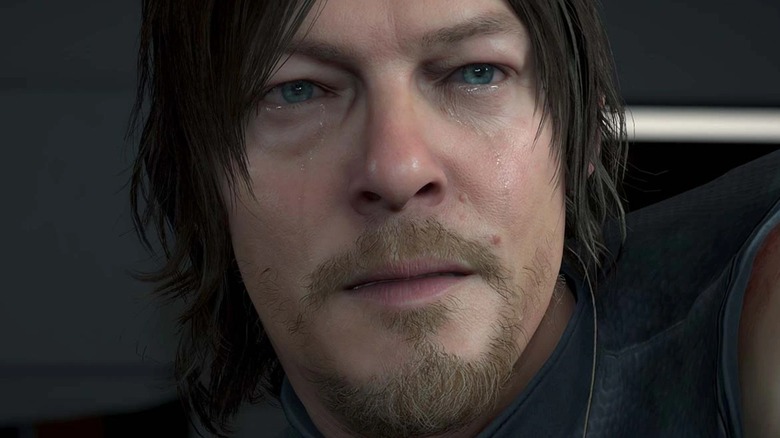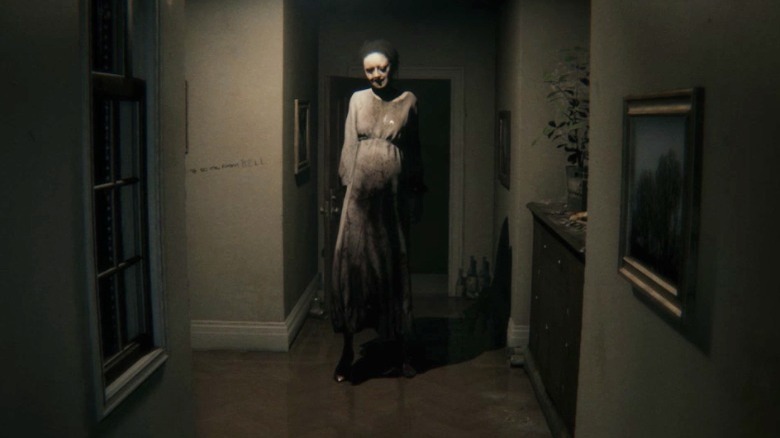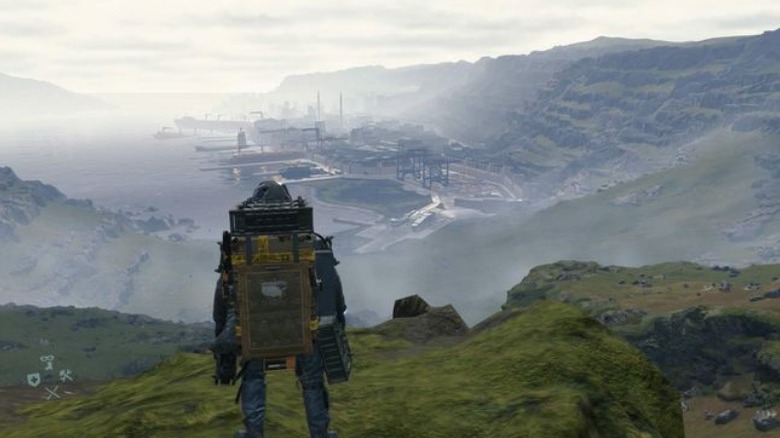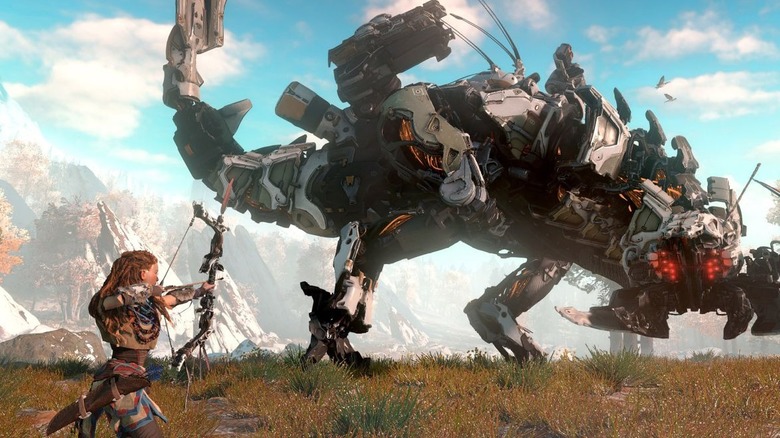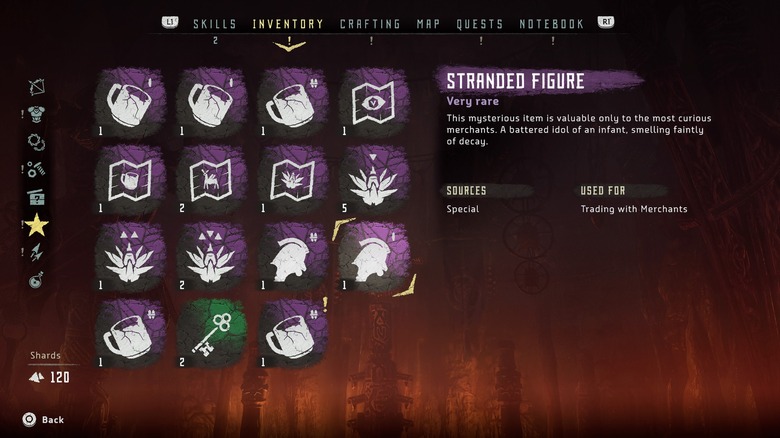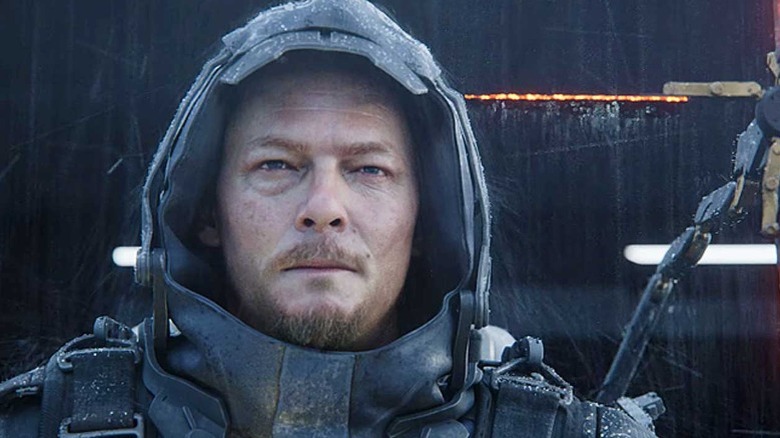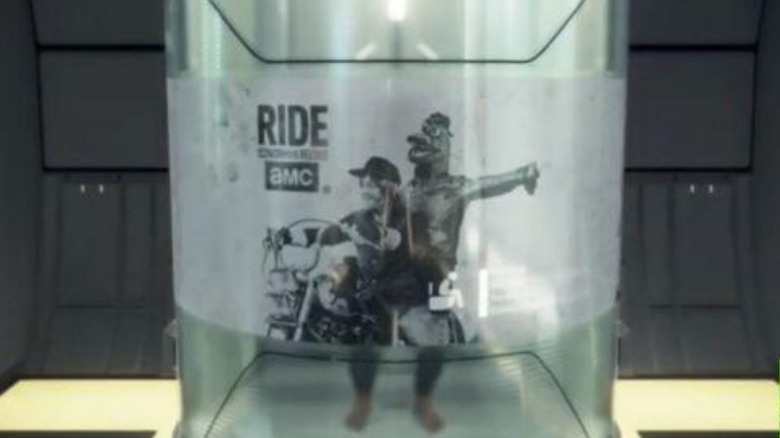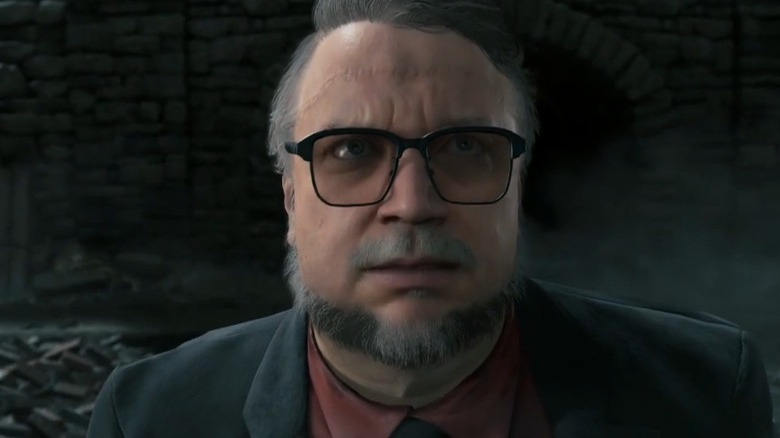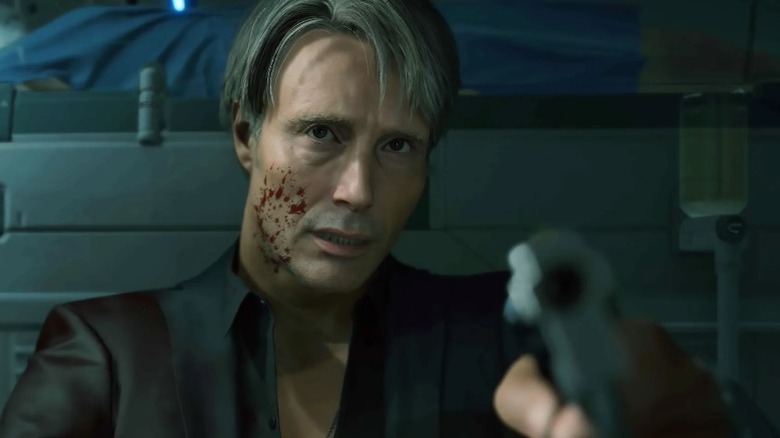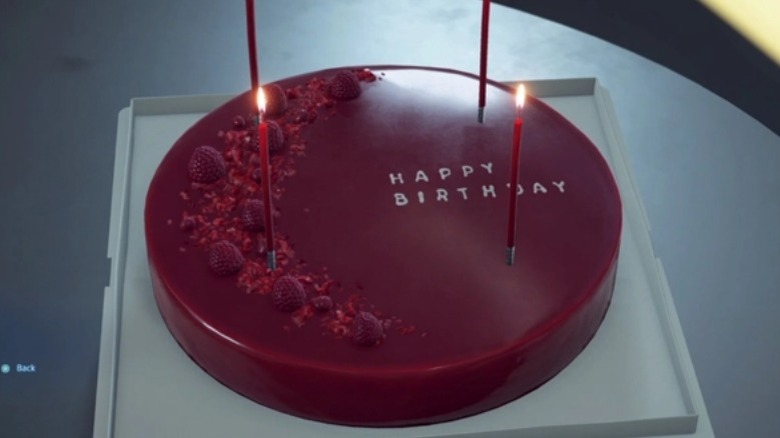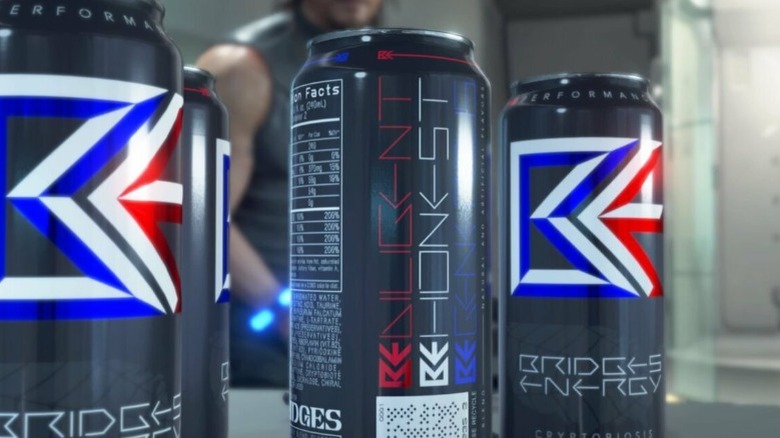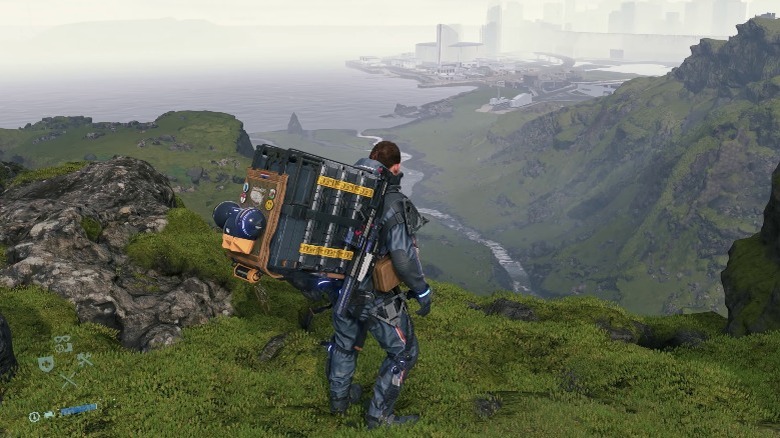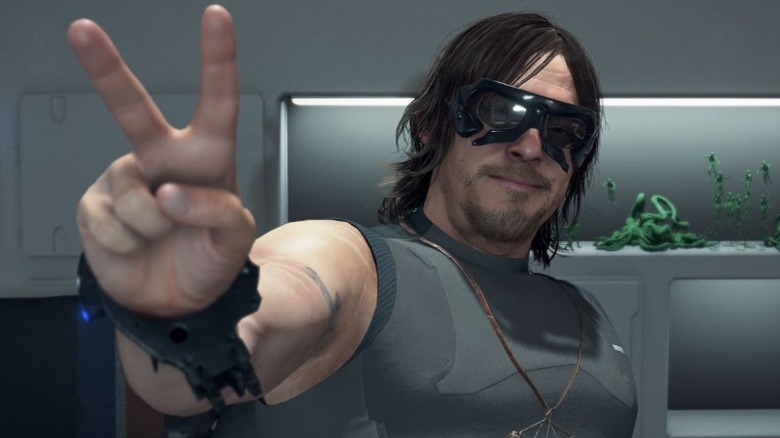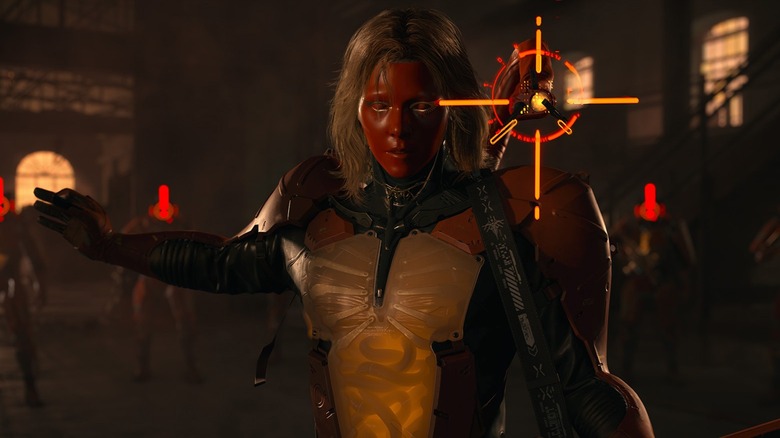The More You Know About Death Stranding, The Weirder It Gets
Hideo Kojima is one of the video game industry's most prominent auteurs, having created the "Metal Gear" series and essentially predicted the future through a number of his narratives. So when he announced in 2016 that he was working on a new game called "Death Stranding," many people were understandably excited — especially when it came after his high-profile split from Konami.
Launching in 2019, "Death Stranding" became one of the most talked-about games of the year. Since then, the title has seen a PC port and an upgraded version for the PlayStation 5. Starring Norman Reedus as Sam Porter Bridges, the story is set to continue with "Death Stranding 2," a game that already has fans speculating about where the narrative will go.
With "Death Stranding" being such a big game that has so many elements to it, it's very easy for players to have missed some hidden details and behind-the-scenes stories that lend even more substance to the project. Here are some things you might not have known about "Death Stranding."
Death Stranding was created when a new Silent Hill game died
Hideo Kojima had a long association with Konami, having created "Metal Gear" while working at the company and later forming his own subsidiary, Kojima Productions, in collaboration with the publisher. He was a producer, writer, or director (sometimes all at once) on many Konami games up until his departure in 2015. In that year, there were several rumors suggesting that Kojima was set to leave Konami, and the publisher went so far as to remove his name from its websites and promotional material.
His final two games before his departure were "Metal Gear Solid 5: The Phantom Pain" in 2015 and "P.T.," a playable teaser that was meant to promote "Silent Hills." Norman Reedus was also due to play an integral part in this game before Konami officially shelved it. Acclaimed film director Guillermo del Toro was meant to be a part of this project as well, and he has since seemingly expressed his frustration with Konami for its decision on Twitter. Reedus, del Toro, and Kojima would all work together again on the first new game the beloved game developer made outside of Konami's control — "Death Stranding."
Music helped to shape Death Stranding
Unlike a lot of AAA games that are released today, which tend to use orchestral scores and original music, "Death Stranding" takes a different approach. While there is original music in the game, a significant portion of the songs in "Death Stranding" are licensed tracks from a wide array of artists. The soundtrack album "Death Stranding: Timefall" spotlights a number of these artists, including Major Lazer, Khalid, The Neighbourhood, Bring Me the Horizon, and The S.L.P.
Speaking to Eurogamer, Kojima explained his choice of music and said "I try to be connected to the actors, film directors, authors, artists, and musicians I personally like. The way I select the music or artists is based on trust I establish with them."
Some of the most prominent music in the game came from the band Low Roar. Kojima's decision to use Low Roar's songs in the game was made because the director "thought Low Roar's music would match this harsh but beautiful and pure environmental setting." Kojima also complimented the band's "acoustic but digital futuristic sound," which paired well with his vision fo the game.
The influence of Low Roar on the overall experience cannot be overstated. In fact, following the death of the band's frontman, Ryan Karazija, Kojima paid tribute to him and the group's music, tweeting, "Without Ryan, without you and your music, 'Death Stranding' would not have been born."
The Horizon Zero Dawn connection
While working at Konami, Kojikma Productions had most recently used the Fox Engine for "Metal Gear Solid 5: The Phantom Pain." However, this software was owned by Konami, meaning the developer could not then use the proprietary engine for "Death Stranding."
Speaking in an interview with IGN, Kojima revealed that he and PS4 system architect Mark Cerny spent several weeks trying to find the best engine that would fit the open world nature of the title.
One of the leading contenders was the Decima engine, which was created by Guerrilla Games and used for "Horizon Zero Dawn" (and later, "Horizon Forbidden West"). Upon meeting with members of the Dutch studio, Decima was gifted to Kojima Productions. In an official PlayStation blog post, Kojima said: "We had no contract with Guerrilla Games, but when we met them they suddenly gave us a box, a very pretty box. When we opened the box, there was a USB dongle inside that had the source code for the engine."
Kojima added that this opened the door for further collaboration: "There was one condition though, that Kojima Productions doesn't just use the engine, but that we develop the engine together with Guerrilla Games, that it should be a collaborative effort."
You can also find Death Stranding easter eggs in Horizon Zero Dawn
Hideo Kojima announced Guerrilla Games — along with its Decima Engine — as his "technology partner" for "Death Stranding" in late 2016. But it seems like both Kojima and Guerrilla struck a deal ahead of that time. Why is that, you ask? Because some "Death Stranding" Easter eggs made it into "Horizon Zero Dawn," which released a mere few months later in February 2017.
The Easter eggs themselves are your run-of-the-mill nods to another game property, consisting of a necklace, figurine, and shackles — all of which appeared in "Death Stranding" trailers. There is, however, a weird twist involved with them. If you manage to play "Horizon Zero Dawn" and find the in-game items related to "Death Stranding," the one vendor you can trade them with gives you a "mysterious box" in return. And what's in that box, exactly? Warm socks.
Sony was impressed with how quickly the game came together
It isn't unusual for games to take many years to complete. In fact, some titles can languish in development hell for more than a decade, as in the case of "Duke Nukem Forever," which ended up being a mess, or "Beyond Good and Evil 2," which fans are still waiting for. So it wouldn't have been a huge surprise if an ambitious game "Death Stranding" had taken a much longer time in the oven than it actually required.
That wasn't the case with Kojima's game, though. Kojima revealed to Dengeki PlayStation that Sony Interactive Entertainment was extremely impressed by the game's progress, and that the company had "never before seen a game being created at such a fast pace" (via Wccftech).
This rapid pace of development meant that Sony was even willing to make announcements about "Death Stranding" early, driving up the hype for the game even more. The director later revealed to GameSpot that development only lasted around three years with a team of 80 people working on it over that period of time.
Norman Reedus also exists in this Norman Reedus game
Like any Hideo Kojima game, "Death Stranding" is filled with a wide array of Easter eggs. For instance, players will get a special cake if they play the game on their birthday. So it shouldn't come as much of a surprise to fans that Norman Reedus also apparently exists within the world of "Death Stranding," at least according to an Easter egg tied to his AMC travel series, "Ride with Norman Reedus."
While using the toilet in Sam's private room, a holographic advertisement for the show can pop up on the screen behind him, suggesting that it's a television series in the game's own universe. It's also possible to gain access to the "Ride" type Reverse trike to get Sam where he needs to go – and the in-game description specifically mentions "Ride with Norman Reedus" as the inspiration behind the vehicle.
The series, which first began airing in 2016, followed the actor traveling around different cities with special celebrity guests, including "The Walking Dead" co-stars Melissa McBride, Michael Rooker, and Steven Yeun.
Celebrities are everywhere in the game
The legendary designer of "Death Stranding" is widely regarded as an auteur within the game industry, not to mention one of the few developers who have become famous figures outside of their work, in a similar vein to Nintendo's Shigeru Miyamoto. With that in mind, it makes some sense that Kojima would be held in high esteem by his peers and other notable people within the world of entertainment. That might explain why "Death Stranding" is so full of celebrity cameos, as many famous personalities are also fans of Kojima's work and were more than happy to be a part of a game they were already anticipating.
A wide array of familiar faces are scattered throughout the campaign. For example, famous late night host and comedian Conan O'Brien shows up as The Wandering MC and cracks jokes to the player. Other celebrities make peculiar appearances in the game, including "Shaun of the Dead" filmmaker Edgar Wright, journalist and Game Awards host Geoff Keighley, Remedy Entertainment creative director Sam Lake, and "Kong: Skull Island" director Jordan Vogt-Roberts (who is attached to direct an adaptation of Kojima's "Metal Gear Solid"). And naturally, Kojima's would-be collaborator on "Silent Hills," Guillermo del Toro, appears as the character Deadman.
The actors didn't really understand the story
Kojima is well known for his complex plots, and "Death Stranding" is no different. Even those who have played much of the campaign may struggle to understand fully what is going on and need the story explained to them. The game is set in a post-apocalyptic future where the United States has been devastated by a series of supernatural events. Entities called BTs now attack humans, causing massive explosions around the country, and a mysterious phenomenon called Timefall speeds up time wherever it rains down. With humanity driven indoors, the player takes control of a courier who transports cargo between settlements.
It's a lot to wrap one's head around, and it turns out that even those deeply involved in the game may not have fully understood everything. According to Polygon, actor Mads Mikkelsen told an audience at Saudi Comic Con that he had difficulty getting to grips with the story when Kojima explained it to him, saying, "He was trying to tell me the whole plot of the game, and it's so elaborate that ... I mean, I got lost."
Meanwhile, Norman Reedus revealed to The Hollywood Reporter that one of his first reactions when being told about the story was "what are you talking about?" When speaking to The Scottish Sun, voice actor Troy Baker said that even Kojima himself didn't fully understand "Death Stranding."
Sam will attack the camera if you keep staring
Although pessimistic and anti-social, Sam Porter Bridges is not exactly someone who spoils for a fight. The character also has aphenphosmphobia, a deep fear of being touched, so he will generally go out of his way to avoid any physical contact whenever possible. But all of that won't stop him from becoming surprisingly angry and attacking the player themselves in a specific set of circumstances.
Many fans who have played "Death Stranding" may not even know about this hidden feature. During a section when you don't directly control the protagonist, it is possible to move the camera around to focus on different areas. Looking directly at Sam's crotch will cause him to try to cover up and forcefully ask you to stop. If you keep trying to look at the groin area, the Norman Reedus character will become confrontational, grab the camera, and throw a punch at the person controlling it — which in this case is the player.
This may well be a nod to another similar Easter egg in "Metal Gear Solid," when Meryl will get angry if Solid Snake continues to stare at her.
Every cake featured in the game was homemade (and eaten)
"Death Stranding" features a number of cakes scattered throughout its post-apocalyptic landscape. The most notable of these is the one featured in the aforementioned easter egg, gifted to players in their private room if they play the game on their actual birthday (which must be entered when first starting up the game). This little touch will certainly have provided a few smiles to some players, but would you believe that these delicious confections were real at one point?
Unlike the one teased throughout "Portal," the cake in "Death Stranding" is not a lie. Giving fans a behind-the-scenes look at how the game was made, Kojima explained on Twitter that the cakes in the game were actually based on real-life cakes baked by the development team. These were then digitally scanned into the game, giving them their realistic appearance. As an added bonus, staff at Kojima Productions got to eat those cakes afterward.
The Director's Cut is more than just an update
A Director's Cut is something that people will probably associate more with movies than video games. After all, it isn't unusual for a popular or successful video game to get a new edition sometime after its release, but these are usually billed as a Game of the Year or Complete Edition. In the case of "Death Stranding," though, fans can get a "Director's Cut" that is more than just a standard re-release.
Among the many differences, "Death Stranding: Director's Cut" allows players to change the game's graphical setting changes, picking between performance and presentation modes by favoritng either a higher resolution or more stable framerate. This version of the game has also added some improvements to both the gameplay and the story. Players can now equip gloves for hand-to-hand combat and faster climbing, along with a host of new items meant to make it easier to battle enemies. New action-oriented stealth missions and a firing range also offer a new challenge.
Highways can also be extended into the mountainous regions, making getting around a little quicker and less troublesome. For those who didn't enjoy the product placement of Monster Energy cans in the original game, the Director's Cut is also free of them as well, replaced with Bridges Energy (per Polygon).
It should be noted that Kojima himself disagreed with calling this release the "Director's Cut," but the positive reviews for the expanded edition speak for themselves.
COVID-19 parallels
Kojima has been purported by some fans in the past to have predicted future events with his previous games, such as the "Metal Gear" series. When it came to "Death Stranding," many players noted similarities between the events of the game and the COVID-19 pandemic that has affected the real world over the last few years, particularly since the game was released on the cusp of the outbreak.
hold up a sec
right now:
- society is divided along political lines
- sudden onset of a nigh-inescapable illness
- paranoia setting in rapidly
- everyone relying on delivery services to avoid going outARE YOU KIDDING ME KOJIMA@Kojima_Hideo pic.twitter.com/P0CoRl4j8W
— Nitroid❗ (@Nitroid) March 6, 2020
One of the main plot elements of "Death Stranding" concerns the idea that the majority of the world is living in strict isolation, afraid to go outside due to an invisible threat that threatens to cause mass devastation. The real world parallels go even further, as delivery people suddenly become the only ones allowed to go outside and travel around, transporting vital supplies.
Now imagine you’ve been quarantined for some time. Supplies are low & it seems pretty hopeless as you’re afraid to go out. Along comes a stranger bringing exactly what you need in exchange for joining the chiral network. That’s Sam Bridges delivering hope 😃 pic.twitter.com/EA9dUdrNYc
— Peter Tieryas (@TieryasXu) March 15, 2020
Kojima himself has even acknowledged the ways in which "Death Stranding" was a bit prophetic. During The Game Awards' 2022 ceremony, Kojima told host Geoff Keighley that he had changed some of the story of "Death Stranding 2" from his original conception, saying he "didn't want to predict any more future, so [he] rewrote it."
Death Stranding was review bombed on Metacritic
A rather unsavory aspect of the entertainment industry is that some people will review bomb releases. This is a process by which users leave negative reviews on sites about a game, film, or television series in response to something other than the content of the actual product. Sometimes this is the result of trolling, while other times it's done to protest the actions of someone involved in the production of the title at hand. For example, "Total War: Warhammer 3" was review bombed when fans were dismayed with the studio's promotional campaign, which spoiled plot points and gave review codes to streamers with little to no interest in the title.
As it turns out, "Death Stranding" was also review bombed when it first hit store shelves. In the first days after the game came out, it had hundreds of negative reviews, with many scores sitting at 0/10. A number of these reviews came from people who admitted they had not yet played the game, while some of these reviews charged that journalists had been paid to write positive coverage for "Death Stranding.
As noted by TheGamer, this process was repeated when "Death Stranding: Director's Cut" launched in 2021. It remains to be seen if "Death Stranding 2" will follow suit.
We know very little about the sequel
The success of "Death Stranding" seemed to ensure that Hideo Kojima and his studio would start work on a sequel almost immediately. However, official confirmation of the sequel didn't arrive until December 2022, when a brief teaser trailer was shown during The Game Awards. This video provided the first clues about what fans can expect from the second installment and contained some hidden details calling back to the first game, as well as new looks for Sam (who has seemingly aged greatly), Fragile, and baby Louise.
The trailer itself is pretty much the limit of what we know about "Death Stranding 2" so far. It isn't clear exactly when the sequel takes place, nor what will prompt Sam back into action. It's not even clear what the game will be called, since the YouTube listing for the trailer refers to "Death Stranding 2" as a "working title." Of course, that hasn't stopped fans from speculating about story possibilities or prevented the rumor mill from starting up.
However, it looks like fans will have to wait a good while before getting their hands on the game, as a resume page for a senior artist who worked on the title indicated it's not due to hit store shelves until 2024.

